[disclose]
We generally don’t receive too many submissions for the United States. We think much of it has to do with what we believe is inherent bias on collecting passport stamps and U.S. destinations just don’t give any.
So we were excited when Marissa from Life As Marissa submitted her practical travel tips to Washington, D.C.
If you would like to write about your recent travel experiences on The Flight Deal, submit your pitch here.
====
Washington, D.C. is best known as being the seat of government for the United States of America. For those who live in D.C., it is much more than that: The Nation’s Capital a is young, diverse city with global influences that can be found in its dining options, culture, and architecture.
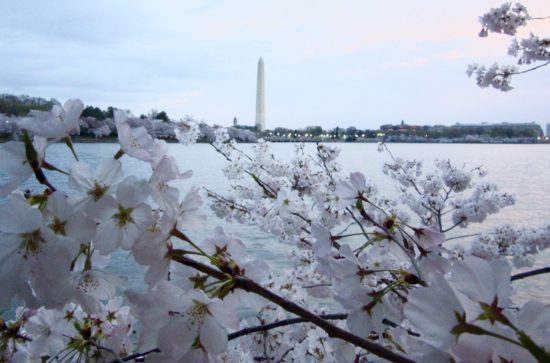
The cherry blossoms at sunrise, looking toward the Washington Monument. – Photo: (c) 2017 – Marissa of Life As Marissa
Getting to D.C.
The Washington, D.C. area is serviced by three major airports:
Ronald Reagan Washington National Airport (DCA): This is the closest airport to Washington, D.C. and the most convenient to get into the city. Reagan National Airport is located on the banks of the Potomac River near Alexandria, Virginia. On a clear day, those who fly into DCA are treated to panoramic views of the city as they land. The airport is relatively small, despite the volume of travelers passing through on a daily basis, and does not require extra time before a flight to navigate security or terminals.
Metered taxis into downtown D.C. are available outside of baggage claim and cost about $20 after tip. Uber service into the city runs about $12-14. Two metro lines – Blue and Yellow – also service the airport. Fares into the city run between $2-4, depending on the time of day.
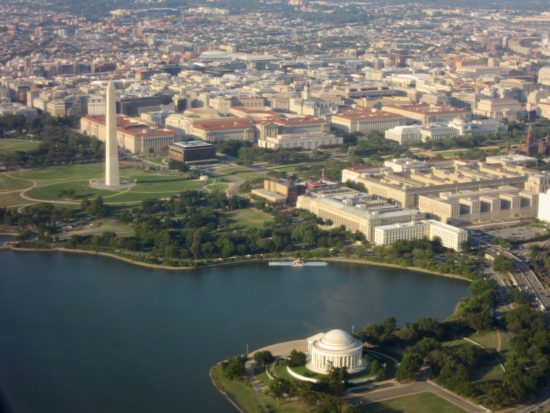
Aerial view of Washington, D.C. during take-off from Reagan National Airport. – Photo: (c) 2017 – Marissa of Life As Marissa
Washington Dulles International Airport (IAD): Dulles is possibly the best-known airport in the metro area, though it is the smallest of the three in terms of total passenger count. A majority of international travelers pass through Dulles when traveling to and from the area.
Dulles is located 26 miles from Washington, D.C. suburban Virginia. Transportation to/from the airport can be tricky, as the metrorail system will not offer service to Dulles until 2019. In the meantime, visitors can catch the Silver Line Express bus ($5 each way, running every 15-20 minutes outside of Arrivals Door #4) to the Wiehle-Reston stop, which offers Silver Line rail service into D.C. The 5A metro bus offers direct roundtrip bus service to L’Enfant Plaza and Rosslyn metro stops in the District ($7 each way). Taxis and Ubers are also an option but can be costly and are at the mercy of D.C.’s legendary and unpredictable traffic.
Baltimore-Washington International Airport (BWI): BWI is the busiest airport in the metro area by passenger count. It is a Southwest Airlines hub that receives both domestic and international air traffic.
The best way to get from BWI to D.C. is to take the MARC or Amtrak trains from the airport to Union Station. The free BWI Marshall Airport Shuttle takes travelers from the terminals to the train station about a mile away. A MARC ticket to Union Station is $7 and Amtrak tickets start at $16. Tickets can be purchased at the rail station.
Getting Around
You’ll hear locals gripe about the D.C. subway system (known as “the metro”), but for travelers who don’t rely on it for their daily commute, it’s an extremely efficient way to get around the city.
- There are six lines that make up the metro system: Orange, Blue, Yellow, Green, Red, and Silver. All lines have at least one stop on or near the National Mall, though you may have to make a connection if you choose to go to other parts of the city.
- Like most subway systems, all trains and arrival signs will display the line and final destination of incoming trains. Tall columns on each side of the platform list which stops are serviced by that side of the platform, and which stations offer connections to other lines.
- Reloadable SmarTrip cards are the most convenient way to pay fares. SmarTrip cards can be purchased at most metro stations, through WMATA.com, or at select retail and commuter stores. They cost $10 and come pre-loaded with $5 for your next ride. If you opt for a paper fare card, you will be charged $1 extra for your fare.
- Fares are registered both as you enter and exit the metro station. This means you need to swipe a fare card or SmarTrip card to gain access to the train platforms, and swipe it again to exit the station (funds are deducted as you exit). If you are using a single-ride paper fare card, be sure to hold onto it until you are outside of the station of your final destination! (Editor’s Note: Minor correction to this – All fares are now SmarTrip card – no more paper tickets)
- Trains run every few minutes during morning and evening rush hour, and every 10-20 minutes during off-peak times. Fares also rise during peak hours.
Metrobus provides service to all corners of the city and is a convenient way to get to places that aren’t serviced by rail. Buses are clean and comfortable, and locals often prefer them over the metro. Fares are $1.75 per ride, and SmarTrip cards are accepted on all buses.
Where to Stay and Hang Out
Hotels in D.C. run the gamut from budget to ultra luxury. Most familiar brands have properties in the city. Basic hotels start at around $100/night, and mid-range chains will come in around $200-$250/night depending on the time of year.
Airbnb is a good option for those looking to have a more authentic experience. You can rent an entire apartment for less than $100/night, so it’s a good alternative to hotels for the budget-conscious.
The best way to figure out where to stay is to first determine which neighborhood in D.C. you want to spend time in. Are you a history buff? Do you seek out the District’s unique cultural offerings? Are you here to shop? Is politics your jam? D.C.’s neighborhoods all have something different to offer, and their unique vibe will undoubtedly leave an impression. Here are some notable ones:
- Foggy Bottom: If your plans will take you to the John F. Kennedy Center for the Performing Arts or onto the National Mall, then Foggy Bottom is a great place to stay. It is home to George Washington University and the United States Department of State. Serviced by the eponymous Orange Line station, and walkable to the Lincoln Memorial.
- Dupont Circle: A historic and affluent area butting up against the downtown business district. A great choice if you like to walk everywhere, though there is ample metro and bus coverage. Close to the historic mansions of Kalorama, Embassy Row, and the nightlife on Connecticut Avenue, 17th Street, and Adams Morgan.
- Georgetown: The District’s famous shopping destination. Georgetown is historic, being one of the first settlements in what would later become Washington, D.C. Low, colorful buildings and homes give this area its unique charm. It does not offer metro service, however, so you will have to walk, take the bus, or catch an Uber to visit other parts of D.C.
- Metro Center/Penn Quarter/Chinatown: If you plan to be on or around the National Mall’s monuments and museums for most of your visit, this area will be the most conveniently-situated for you. It sits mere blocks from the middle of the National Mall and has loads of good shopping and dining. It is serviced by all metro lines.
- Capitol Hill/Eastern Market: A quieter part of the city that’s home to many Hill staffers and government workers. Like Georgetown, Capitol Hill features beautiful tree-lined streets with colorful row homes. It’s not known for its nightlife, but Eastern Market has a fantastic local farmers’ market and flea market on the weekends.
- H Street Northeast: A young, hip, up-and-coming area with great restaurants and nightlife. H Street has a more authentic and casual vibe than many of its buttoned-up neighbors. The newly-installed streetcar system provides easy access to nearby Union Station.
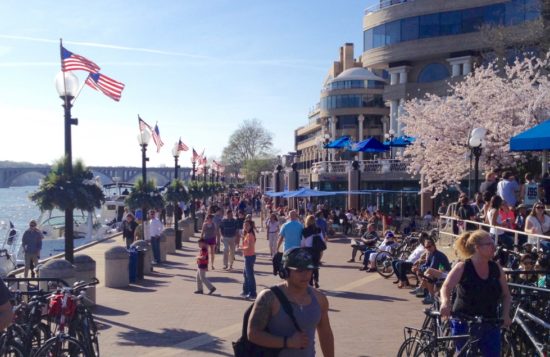
The bustling Georgetown Waterfront. – Photo: (c) 2017 – Marissa of Life As Marissa
Where to Eat
Washington, D.C. received its first-ever Michelin guide in 2016, a testament to its maturing food scene. The city has blossomed over the last decade into a dining destination, catering to more than just suits with expense accounts. D.C.’s international influences are perhaps most evident in the array of ethnic offerings you can find throughout the city.
D.C. is best known for mumbo sauce (a tangy, spicy sauce that originated here), half-smokes (you can find them at Ben’s Chili Bowl on U Street), jumbo slice pizza, Ethiopian food, weekend brunch.
While great restaurants can be found throughout the city, 14th Street in Northwest D.C. has emerged as a foodie destination. Dozens of diverse restaurants line a mile-long stretch of this road that’s just east of Dupont Circle. It’s known for attracting some of D.C.’s most famous residents, including the Obamas.
Plan to spend a pretty penny when dining out. Though there are plenty of affordable fast-casual chains to choose from, you would be wise to avoid them in favor of eating at any of the abundant local spots. Dining in D.C. isn’t particularly cheap, but it’s an essential experience in the city.
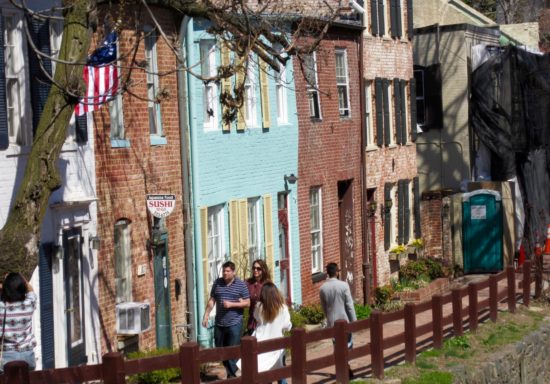
Colorful façades in Georgetown. – Photo: (c) 2017 – Marissa of Life As Marissa
What to See and Do: The National Mall
D.C. has enough major landmarks to fill a week-long itinerary. If you only have a couple of days in the city, focus on the National Mall. If you have more time, be sure to venture into the surrounding neighborhoods to see other historic sights and take in some of the local flavor.
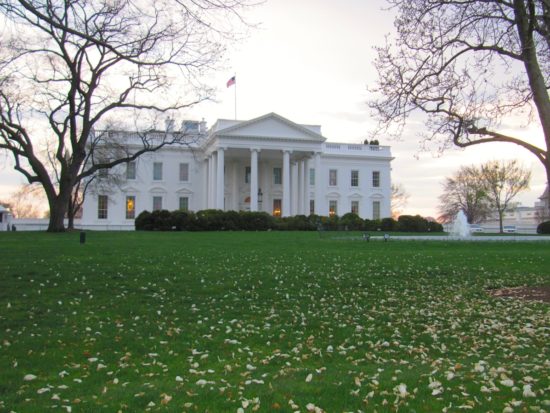
The White House – Photo: (c) 2017 – Marissa of Life As Marissa
Here is a listing of the major sights on or around the National Mall, and how long you should plan to spend at each:
- The White House: 30 minutes, or 2 hours if you’re touring the inside.
- The U.S. Capitol: 2 hours
- Washington Monument: 30 minutes
- World War II Memorial: 45 minutes
- Martin Luther King, Jr. Memorial: 30 minutes
- Thomas Jefferson Memorial: 30 minutes
- Korean War Memorial: 30 minutes
- Lincoln Memorial: 30 minutes
- Vietnam War Memorial: 30 minutes
- National Museum of American History: 2-3 hours
- National Museum of Natural History: 3-4 hours
- National Art Gallery: 3-4 hours
- National Museum of African American History and Culture: 5-6 hours
- National Air and Space Museum: 2-3 hours
- National Archives: 2 hours
- National Portrait Gallery: 2-3 hours
- Holocaust Museum: 3-4 hours
The National Mall is deceptively long – 2.5 miles end to end. Plan to split its many sights into at least two days. Segway tours are a great way to save your feet and see all of the monuments in a condensed period of time.
All monuments on the National Mall are free, including the Smithsonian museums and the U.S. Capitol. Note that the Holocaust Museum, which is not a Smithsonian institution, does charge entry.
Advance reservations are recommended or required at the U.S Capitol, the White House, the Holocaust Museum, and the National Museum of African American History and Culture.
What to See and Do: Elsewhere in the District
- Arlington Cemetery: 4-5 hours
- Washington National Cathedral: 2 hours
- John F. Kennedy Center for the Performing Arts: 1-2 hours if you tour or eat at the restaurant; 4+ hours if you catch a show
- Shops on M Street & Wisconsin Avenue in Georgetown: 4 hours
- The Georgetown Waterfront: 1-2 hours
- Embassy Row: 3 hours
- The Newseum: 6+ hours
- Historic neighborhoods including Kalorama and Dupont Circle: 4 hours
- Eastern Market: 2-3 hours
- Day trips to Alexandria, Virginia and Mount Vernon (George Washington’s residence) are a wonderful way to escape the city. Alexandria is accessible via the Blue Line. It is easiest to travel to Mount Vernon by car, though the Fairfax Connector bus #101 will take you there from the Huntington stop on the Yellow Line.
- D.C. has a number of professional sports teams: the Washington Redskins (football), the Washington Capitals (hockey), the Washington Nationals (baseball), the Washington Wizards (basketball), and D.C. United (soccer). If you’re interested in catching a game, all stadiums and arenas are accessible via metro.
When to Visit
The best times of year to visit D.C. are in the spring and fall. The National Cherry Blossom Festival takes place in late March/early April every year, when the city is perhaps at its most attractive. D.C. comes alive in the spring as the weather turns warmer and people venture out after hibernating all winter. But the most opportune time to visit may be in the fall, when the city clears out after school resumes. The weather is consistently beautiful and not too muggy, hotels offer off-season rates, and there are far fewer tourists to compete with.
Safety
D.C. has a high crime rate compared to other cities, but that shouldn’t deter you from visiting. Most major tourist areas experience very little crime. D.C. Metropolitan Police are omnipresent. That being said, always exercise common sense: keep belongings secured and on your body at all times, and always be aware of your surroundings, especially at night.
Other Useful Tips
- Credit cards are accepted nearly everywhere, including taxis.
- Sales tax is 10%. (Editor’s Note: 10% for restaurants. 5.75% for everything else)
- Bring good walking shoes. D.C. is best seen by foot, and it’s easy to log ten miles in a day.
About the Author:
Marissa is a D.C. resident, lifetime adventurer, and part-time blogger. When she’s not working at her full time communications job, you can find her checking out a new restaurant in D.C., painting, or hopping on an airplane to her next destination. She created her blog, Life As Marissa, for those like her who are infinitely curious and have an unquenchable appetite to see and understand the world. You can follow her adventures on Life As Marissa, Instagram, Twitter, Facebook, and Flipboard.
=====
To make sure you receive our latest deals, LIKE our The Flight Deal Facebook Page, follow us on Twitter @TheFlightDeal, Threads @TheFlightDeal or The Flight Deal WhatsApp channel or subscribe to The Flight Deal RSS Feed or Subscribe via Email (Once a Day)
The Flight Deal does not sell travel products or services. We provide you with information about third-party travel suppliers’ offers, and link you to their sites. The information posted by The Flight Deal is valid at the time of publication. However, we have no control over the suppliers, and we therefore do not warrant or guarantee that their offers will not change or become unavailable. Nor are we responsible for their products, services or site content. Please see their sites for their most up-to-date offer information and all applicable terms and conditions.
Sign up to receive The Flight Deal Daily DealsLetter, to stay up to date with the latest and greatest flight deals available.

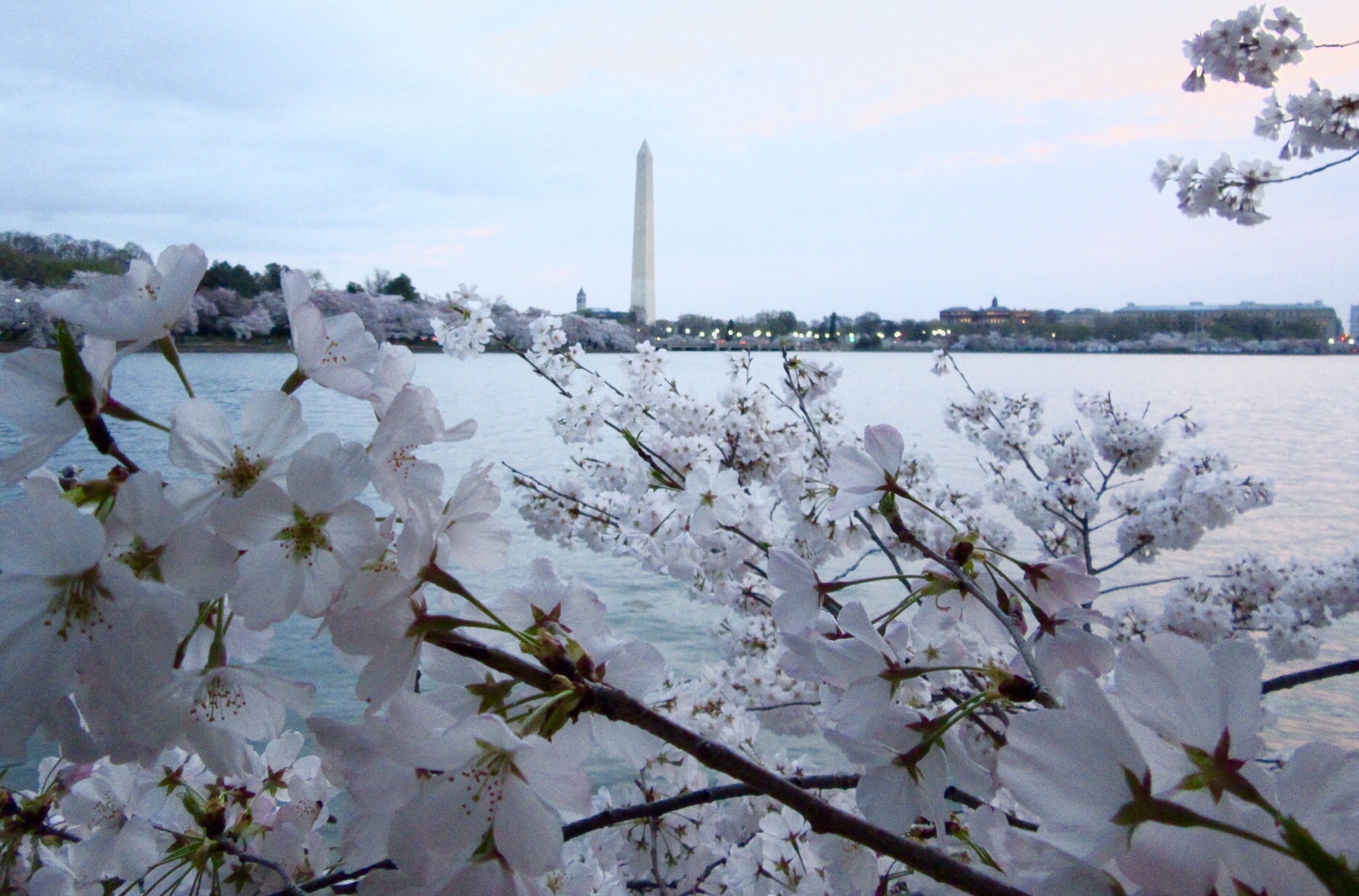
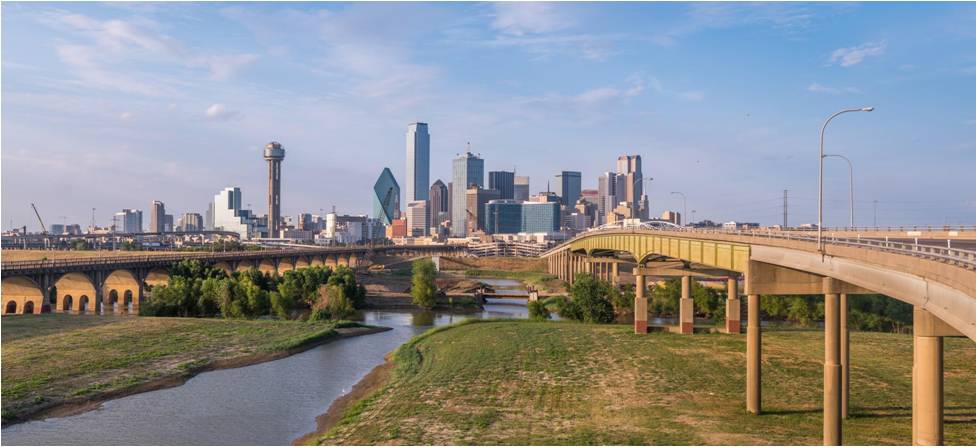

SmarTrip Cards are still $10 to buy, but they come loaded with $8 worth of WMATA credit on them. Also, paper cards are no longer available, everyone must travel with SmarTrip Cards.
Great summary. I would add that the Capital Bikeshare system is also an ideal way for tourists to get around. Day and week passes are available at all of the 300+ stations region-wide and allow for unlimited <30min rides. Especially helpful on the mall and while touring the zoo.
Speaking of the zoo it is a great destination and it's compact but comprehensive nature makes it easily walkable in an afternoon.
I'd also recommend a day trip to Annapolis to see the historic city-center and see the Chesapeake Bay.
Sales tax is 5.75% not 10%.
The sales tax in Washington DC is 5.75% and not 10%. However, it is 10% if you eat at a restaurant inside the District.
Great article! DC is a great place to visit (and live). I wouldn’t worry too much about the crime if you stay within any of the areas the article mentioned. We’ve lived in the H-street area for years and although it is more “authentic” as the author says, we’ve never felt unsafe. Like any large American city, just keep your wits about you and you’ll be fine.
A few additions: Also on the mall is the FDR memorial between the MLK memorial and the Jefferson memorial. It is a much different style than many of the other memorials and worth a stroll (plus you’ll get amazing views of the tidal basin). You’ll probably spend less than an hour making your way from MLK to Jefferson via the FDR memorial.
I also recommend the zoo. Which is also free. Go early if it is nice outside since it can get packed. The Arboretum is also very beautiful in the spring and fall, and also free.
And since this is a travel deal blog, gravelly point in Arlington is a great place to watch the big metal birds land and take off from DCA. None of the locals call DCA Reagan. It is either DCA or National.
H street Trolley is only worth it because it is free. It isn’t necessarily the easiest thing to find from Union Station. I’d recommend taking a stroll through Capital Hill rather than take the trolley if you wanted to visit the H-street area.
Best cocktail in the city is at Copycat. Best ramen is at Toki Underground. Best sandwich is the Chavito at Fast Gourmet (which is a restaurant inside of a gas station…I know it sounds weird but you have to try it). &Pizza is everywhere and consistently delicious. Amsterdam Falafel house is a must try. If you are willing to spend 2 hours in line for food go to Bad Saint. If you are vegan go to Shouk. If you are not vegan, consider eating at Shouk – it is amazing. Don’t bother with burritos here, they are all terrible. If you don’t want to spend 500 dollars for a dinner at Pineapple and Pearls get a Vietnamese Coffee and cinnamon roll from them in the morning for less than 10 dollars (or a chicken sandwich). If you go to a Nats game go to BlueJacket first for some beers. The food scene here is incredible, just do a bit of research before hand because there is a large portion of crappy food aimed at tourists.
Just want to mention that the Holocaust Museum tickets are free, it only costs $1 if you reserve them online in advance; otherwise they’re free! Great tips here!
Great article. Minor point of clarification: FedEx Field (Home of the Redskins) isn’t easily accessible from the Metro. The closest station (Morgan Blvd) is over a mile away from the stadium, and there aren’t metro buses from the station to the stadium Major PITA
I think that the Library of Congress (LOC) is something that cannot be missed. We wondered in because they have a free bag check and the Capitol wouldn’t let us bring in food. It is on of the best buildings that I have seen in DC. It was built to show off to the world and is filled with ornate tiles, art, sculptures, and rare books. By far the most beautiful places in DC. I was expecting to find a library, but found a wonderful museum that I will go back to. There is also the library part… The LOC also has a tunnel back to the capitol building, so when you check your bag you can go to the capitol without going out the front door.